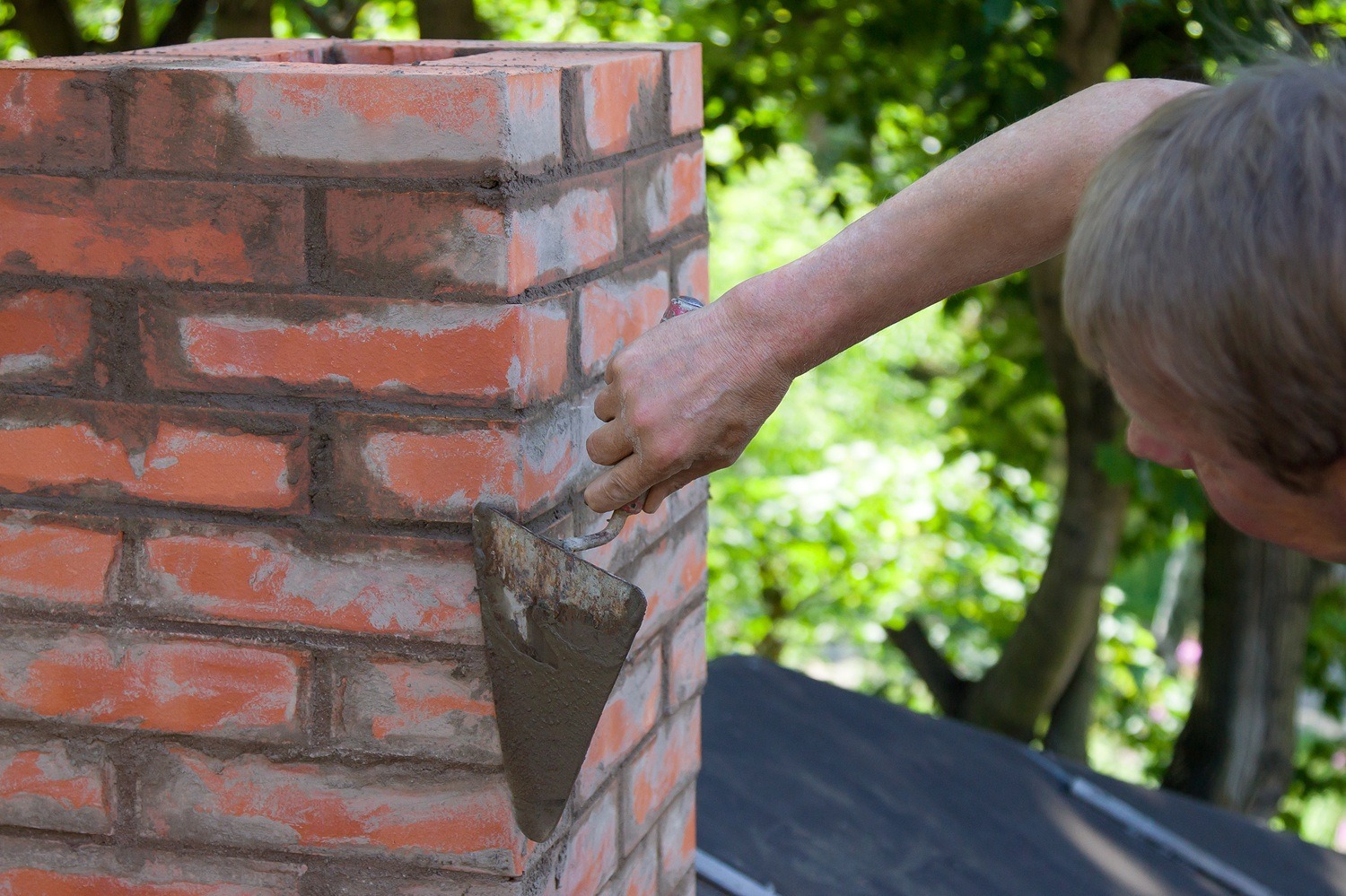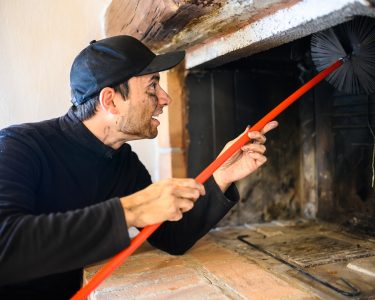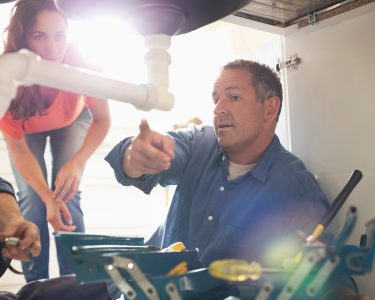Think back to the last time you had a chimney inspection in Santa Clarita, CA. If you’re like most people, you’ll likely find it difficult. Fireplaces and chimneys usually don’t see much use in SoCal, with warm weather around the year.
But, your chimney plays a huge role in protecting your home and family. It just does so silently. Safely venting smoke, heat, and gases like carbon monoxide out of your living space are just a few of the protections your chimney provides
Additionally, it protects your walls and roof from high temperatures, contains stray embers and helps prevent house fires.
Over time, sun exposure, minor earthquakes, moisture, and regular wear take their tolls on your chimney. Unfortunately, cracks, creosote buildup, or damaged caps aren’t always visible. These issues can lead to safety hazards or costly repairs.
That’s why an annual chimney inspection is so important. Furthermore, asking the right questions during that inspection matters. This guide covers 10 essential questions every Santa Clarita homeowner, investor, or property manager should ask to protect their property and stay safe year-round.
1. What Type of Chimney Inspection Are You Performing?
One interesting thing about Santa Clarita chimney inspections is that there are many types. Each type has a different impact on how thorough the process is and what’s discovered.
The three industry-standard levels of chimney inspection are:
- Level 1: This is a basic visual inspection of the accessible parts of the chimney interior and exterior. It’s suitable when the fireplace is in regular use with no changes or known issues. No tools or special equipment are used, and nothing is disassembled.
- Level 2: This includes all elements of a Level 1 inspection. Additionally, it involves video scanning of the flue and an inspection of spaces like attics, basements, or crawlspaces. It’s required when selling a home, after a fire, or following any appliance changes. This level helps uncover hidden damage not visible to the naked eye.
- Level 3: This is the most invasive type of inspection. It’s only done when a serious safety issue is suspected. It may involve removing drywall, masonry, or parts of the chimney structure to investigate further. Inspectors reserve this for major concerns like structural instability or internal collapse.
Ask your inspector which level they’re performing and why. Your chimney’s age, condition, and any recent changes or incidents determine their choice.
2. Can You Spot Signs of Water Damage or Leaks?
Even though it only rains once every month or two in SoCal, water damage is a major concern for the area’s chimneys. The tiniest amount of water seeping into your chimney walls can fester into a huge headache. Masonry chimneys are especially vulnerable. Their bricks and mortar can absorb moisture and deteriorate silently.
Ask your inspector if they see any signs of water infiltration. These may include discolored bricks, spalling (flaking or crumbling), rust on metal components, or visible moisture around the firebox. A faint musty odor could also point to hidden leaks or mold growth inside the flue.
Even in a dry climate, roof runoff and seasonal storms can introduce water into vulnerable spots. Damaged flashing, missing chimney caps, or hairline cracks often go unnoticed until the damage worsens. Water inside your chimney weakens structure and creates the ideal environment for mold.
Exposure to hidden toxins can affect your mood and focus. Learn about the connection between indoor air quality and mental health.
If your inspector finds early signs of water damage, ask what’s causing it and how soon it should be addressed. Sealing a minor leak now can prevent a costly rebuild later.
3. Is the Chimney Cap and Crown in Good Shape?
It’d be horrendous if rain, debris, or even animals got into your chimney, which is what the chimney cap and crown are designed to prevent. Keeping these components in good shape is key to protecting your flue and fireplace.
The chimney cap is a metal cover that sits on top of the flue. It prevents rain from entering, keeps out birds and small animals, and blocks embers from escaping onto your roof. Meanwhile, the crown is the sloped concrete surface that seals the top of the masonry chimney to keep water from pooling.
Ask your inspector about the status of both components. If either is missing, cracked, rusted, or poorly fitted, you have an issue. Even small fractures in the crown can allow water to seep into the brickwork. A rusted or loose chimney cap may not stay in place during high winds, exposing the flue to damage.
If your chimney lacks a cap altogether, or if the crown is deteriorating, request a recommendation. Replacing or repairing these elements is usually straightforward and can prevent much larger issues down the road.
4. Do You See Any Creosote Buildup or Fire Hazards?
Creosote is a highly flammable substance that forms inside your chimney when wood burns. Even a thin layer can ignite if a stray spark travels up the flue. This is one of the leading causes of chimney fires in the U.S., and it’s preventable with routine cleaning.
Ask your inspector if there’s any visible creosote buildup. They may describe it as flaky, tar-like, or glazed. The more hardened and shiny it appears, the more dangerous it becomes. Glazed creosote, in particular, is extremely difficult to remove without special tools or chemical treatments.
You should also ask whether the amount of buildup requires immediate cleaning. In most cases, creosote should be swept away once it reaches 1/8 of an inch in thickness. Even if you rarely use your fireplace, residual buildup from previous use can remain for years.
If your inspector notes creosote buildup, ask how it formed and how to prevent it in the future. Proper burning practices and regular sweeping are key to keeping your chimney safe.
5. Are the Flue and Liner Safe and Functional?
The flue is the inner passageway of your chimney, and the liner is the protective layer inside it. Together, they vent harmful gases and shield your home from extreme heat. Key word: together. If there’s damage on just one, your fireplace could pose serious health and fire risks.
Ask your inspector if the flue is intact and properly sized for your fireplace or stove. A cracked liner can allow carbon monoxide or sparks to escape into walls or living spaces. This risk is especially concerning during renovations . See why lead dust sampling matters during redesigns for more on air quality concerns. In older Santa Clarita homes, clay liners may have shifted or deteriorated with time and seismic activity.
Ask your inspector what material your liner is made of (clay tile, metal, or cast-in-place) and whether it meets California safety standards. Your chimney might not have a liner at all, or it might be compromised. If that’s the frustrating case, it needs to be relined.
The flue and liner must be in perfect sync for safe and efficient operation. Don’t overlook this part of the inspection, especially if your chimney hasn’t been serviced in years.
6. Has There Been Any Structural Deterioration or Masonry Issues?
Even if your chimney looks fine from the ground, there could be hidden damage. Santa Clarita’s regional quirks like heatwaves, shifting soil, and minor earthquakes can gradually weaken masonry over time.
Ask your inspector if they noticed any cracks, loose bricks, or deteriorating mortar joints. Look for signs of leaning or separation from the house, which could indicate structural movement. Spalling (when brick faces flake or crumble) is another red flag that moisture has entered and expanded the surface.
If the chimney passes through your attic or crawlspace, ask if those areas show any gaps or fire risks. Structural issues may not pose an immediate hazard. Even so, putting off dealing with them can lead to expensive repairs later.
If any damage is found, ask what caused it, whether it’s active or stable, and what repairs are recommended. Catching these issues early can save thousands in future restoration work.
7. How Is the Chimney Draft and Ventilation?
A properly working chimney vacuums smoke, gases, and heat upward and out of your home. When it’s pull is weak or obstructed, smoke can back up into your living space. Worse yet, it may allow carbon monoxide to linger indoors.
Ask your inspector if the draft appears strong and consistent. They may check for air movement using a smoke test or by inspecting for blockages. Common culprits include bird nests, creosote buildup, or debris that has fallen into the flue.
Poor draft can also stem from incorrect flue sizing or an improperly functioning damper. If you’ve noticed smoky rooms, slow-burning fires, or strange odors, mention these symptoms during the inspection.
If your draft is underperforming, ask whether adjustments, cleaning, or repairs could help. Good ventilation is a comfort issue and a safety necessity.
8. Is My Fireplace or Wood Stove Compatible with the Chimney?
If you’ve made changes to your fireplace, added a wood stove, or upgraded to a gas insert, it’s possible your chimney can’t handle the new setup. When that’s the case, safety hazards and local code violations rear their ugly heads.
Consider reading our ultimate guide to fireplace repair in Los Angeles for tips on when and how to upgrade safely.
Ask your inspector if your current appliance is properly vented and compatible with the flue’s size and materials. A flue that’s too wide or narrow for your fireplace can cause draft problems, creosote buildup, or overheating. Chimneys designed for wood may not be suitable for gas or pellet-burning appliances.
Also ask whether the venting system meets current California safety standards. In some cases, a stainless steel liner or new connector pipe may be needed to bring everything into compliance.
If your setup isn’t compatible, you don’t always need to replace everything. Often, adjustments or retrofits can solve the issue while preserving your fireplace’s look and function.
9. Are You Certified and Insured to Perform Chimney Inspections in California?
Before trusting anyone with your chimney, make sure they’re qualified to do the job. In California, chimney inspectors should be trained, experienced, and properly insured to protect you and your property.
Ask if the inspector holds certifications from respected industry groups, like the Chimney Safety Institute of America (CSIA) or the National Fireplace Institute (NFI). These credentials show they’ve been trained in safety codes, inspection procedures, and fire prevention best practices.
You should also confirm that the company or individual is fully insured. This includes liability coverage in case of accidental property damage or injury during the inspection. Without it, you could be held financially responsible for something that goes wrong.
If you’re unsure who to hire, consider asking for references or online reviews from other Santa Clarita homeowners. A trustworthy inspector will always be happy to verify their credentials. Need help choosing the right pro? Here are 10 reasons to hire a licensed contractor for specialized jobs like chimney inspections.
10. What Maintenance or Repairs Do You Recommend?
Once the inspection is complete, ask for a clear summary of the findings. Even if your chimney is mostly in good shape, there may be small issues that could grow into bigger problems if left unaddressed. To learn what warning signs to watch for, visit our guide on when your Malibu fireplace needs a chimney inspection.
Ask your inspector to walk you through any concerns they found. What needs to be fixed now, and what can wait? Request photos or videos so you can see exactly what they’re referencing. This is especially helpful when dealing with internal components or roof-level damage.
You should also ask if they can provide a written report and repair estimate or refer you to a local chimney specialist. In Santa Clarita, minor masonry cracks or missing caps can often be fixed quickly. But, only if they’re caught in their infancy.
A trustworthy inspector will help you focus on what needs attention now and what can be monitored over time. That insight can help you plan your home maintenance budget with confidence.
Keep a Chimney Inspection Checklist
It’s easy to forget the details of an inspection, especially if everything seems fine at first glance. That’s why it helps to maintain a simple checklist or log for your chimney. This is particularly important if you own many properties or manage rentals.
Include key information like the inspection date, type of inspection performed, condition of the flue, chimney cap, and masonry, plus any recommended maintenance. If your inspector provides photos or video footage, save those too. This creates a record you can reference later if issues come up or when selling the home.
You’re lacking credibility and value without a documented inspection history. Crucial details might also fall through the cracks, especially during ownership changes.
Protect Your Property With the Right Questions
A chimney inspection is more than just a routine service. It’s an opportunity to protect your home, your family, and your investment. Whether you live in your property full time or manage it as part of a larger portfolio, knowing what to ask during an inspection helps you avoid fire risks, structural issues, and expensive surprises.
In Santa Clarita, where dry weather and seasonal shifts can take a hidden toll on chimneys, annual inspections are essential. By asking the ten questions in this guide, you’ll gain real insight into your chimney’s health.





